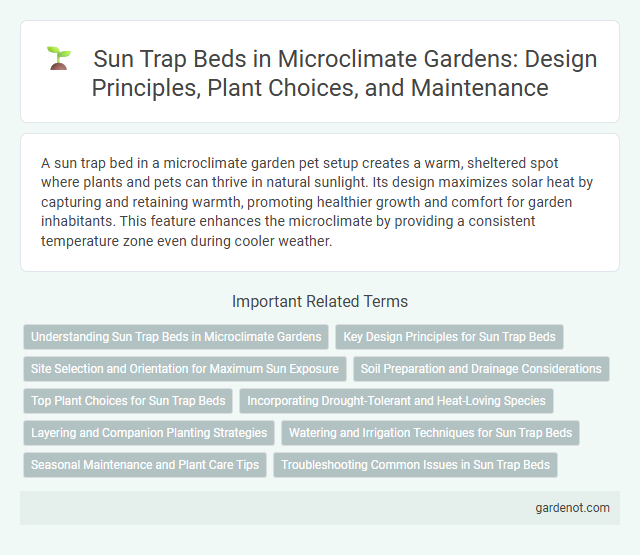A sun trap bed in a microclimate garden pet setup creates a warm, sheltered spot where plants and pets can thrive in natural sunlight. Its design maximizes solar heat by capturing and retaining warmth, promoting healthier growth and comfort for garden inhabitants. This feature enhances the microclimate by providing a consistent temperature zone even during cooler weather.
Understanding Sun Trap Beds in Microclimate Gardens
Sun trap beds are designed to maximize heat and sunlight exposure by positioning plants against warm, sheltered walls or using reflective surfaces to retain warmth. These beds create optimal conditions for heat-loving plants, extending growing seasons in microclimate gardens by reducing frost risk and enhancing soil temperature. Effective sun trap bed construction incorporates materials and layouts that capture and store solar energy, boosting plant growth and resilience.
Key Design Principles for Sun Trap Beds
Sun trap beds maximize solar exposure by positioning walls or dense shrubs on the north side to block cold winds and retain heat, creating a warmer microclimate. Incorporating heavy, heat-retentive materials like stones or bricks within the bed further stabilizes temperature fluctuations. Strategic plant selection favors sun-loving, heat-tolerant species that thrive in the intensified solar environment of the sun trap bed.
Site Selection and Orientation for Maximum Sun Exposure
Selecting a sun trap bed site involves identifying a sheltered location with minimal shading from trees or structures to maximize solar gain. Orienting the bed to face south or southeast ensures prolonged morning to afternoon sun exposure, critical for warmth-loving plants. Incorporating windbreaks like hedges or walls around the site further enhances heat retention and creates an optimal microclimate.
Soil Preparation and Drainage Considerations
Sun trap beds require well-draining soil enriched with organic matter to retain moisture while preventing waterlogging. Proper soil preparation involves loosening compacted soil and incorporating compost or mulch to enhance nutrient availability. Installing a slight slope or drainage channels ensures excess water flows away, protecting plant roots from rot in microclimate gardens.
Top Plant Choices for Sun Trap Beds
Top plant choices for sun trap beds include heat-tolerant and drought-resistant species such as lavender, rosemary, and sedum, which thrive in warm, sheltered microclimates. Mediterranean herbs and succulents optimize sun exposure while conserving moisture, creating a resilient and low-maintenance garden bed. Incorporating these plants enhances the sun trap microclimate by maximizing heat retention and promoting healthy growth in protected areas.
Incorporating Drought-Tolerant and Heat-Loving Species
Sun trap beds maximize warmth by positioning soil in sheltered, sun-exposed areas ideal for drought-tolerant and heat-loving species. Plants like lavender, sedum, and agave thrive in these microclimates due to their ability to conserve water and withstand intense sunlight. Integrating native succulents and Mediterranean herbs enhances garden resilience while reducing irrigation needs.
Layering and Companion Planting Strategies
Sun trap beds optimize microclimate conditions by using layering techniques that place taller plants to shield heat-loving, lower-growing species from wind and frost. Companion planting enhances this setup by pairing plants with complementary needs, such as deep-rooted vegetables alongside shallow-rooted herbs, improving soil health and moisture retention. Strategic layering and companion planting in sun trap beds boost plant resilience, maximize sunlight capture, and increase overall garden productivity.
Watering and Irrigation Techniques for Sun Trap Beds
Sun trap beds require efficient watering techniques that maximize moisture retention in their warm, sheltered environments. Drip irrigation systems deliver precise water directly to plant roots, reducing evaporation and preventing overwatering in sun-exposed areas. Mulching with organic materials further conserves soil moisture and regulates temperature, promoting healthy plant growth in sun trap gardens.
Seasonal Maintenance and Plant Care Tips
Sun trap beds require regular seasonal maintenance to ensure optimal heat retention and soil health, including mulching in winter to protect roots and applying organic compost in spring for nutrient boost. Pruning plants in late winter promotes vigorous growth and better air circulation, reducing disease risks in this warm microclimate. Monitoring moisture levels is crucial; deep watering during dry spells prevents drought stress and supports resilient plant development year-round.
Troubleshooting Common Issues in Sun Trap Beds
Sun trap beds often face issues such as soil overheating, drought stress, and poor plant growth due to inadequate moisture retention and ventilation. To troubleshoot, improve soil composition by incorporating organic matter for better water holding capacity and enhance airflow with strategic plant spacing. Monitoring soil temperature and moisture regularly helps prevent heat damage and ensures optimal conditions for thriving sun-loving plants.
Sun trap bed Infographic

 gardenot.com
gardenot.com